Artist Dan Rizzie searched for the right term to describe the publication this spring of his new monograph, Dan Rizzie by University of Texas Press. Watershed moment? Mile marker? Benchmark?
The mercurial Rizzie, whose work is currently on view, through May 31, 2015, at the Peter Marcelle Project in Southampton, let the question hang for just a few seconds during a recent interview at his North Haven studio. Then he moved on.
“It’s a huge, huge accomplishment,” he said of the book’s publication, which coincided with his 64th birthday. “Now I feel, and the book’s a large part of this … it almost feels like I have come full circle.”
Starting in 2012, Rizzie immersed himself in the project for some three years. He heaped praise on the people who kept him on track and helped him put the handsome coffee table book together. These include, first and foremost, his project manager, Carlos Lama, who is the husband of Parrish Art Museum Curator of Special Projects Andrea Grover. Next in line for his gratitude is his editor, Parrish Art Museum Director Terrie Sultan, whose extensive interview with the artist is included in the book.
Other contributors to the monograph include Jane Livingston, who wrote the introduction, and Mark Smith, whose essay “highlights Rizzie’s development and importance as a printmaker,” according to the publisher.
The artist said that he continued to make new paintings and prints and to show while he was working on the book, which presents 100 works—paintings, collage, and prints—representative of the arc of his career over some 40 years, from the late 1970s to 2010.
Now that it’s done, he says that he’s ready to start over again. He’s thinking of circling back to the way he saw things when he first knew he wanted to be an artist, in high school in India.
“I’d like to start anew with some of the original ideas I had 25 to 35 years ago,” he said. “A more minimal, more focused vision; going away from some of the more decorative qualities—not that I feel bad about that aspect of the work I’ve done.”
.
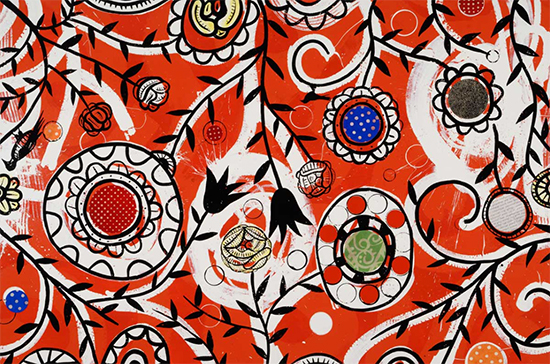
Artwork by Dan Rizzie.
.
“The years have gone by so fast,” he said, briefly ruminating. “I want to look at images I created 30 years ago and explore them more.”
As an undergraduate at Hendrix College in Arkansas, and then as a graduate student at the Meadows School of the Arts at Southern Methodist University in Dallas, Texas, Rizzie said his early influences included Bryce Marden, Cy Twombly and Jasper Johns.
His career got jump started with sales of his work in a very successful thesis show in Dallas in 1975. While his imagery has changed several times over the years, the artist characterized himself as being “from the beginning, a minimalist abstract artist, a geometric abstractionist, with no recognizable shapes in my work”—other than circles, which have always captivated his imagination as “the perfect shape.”
.
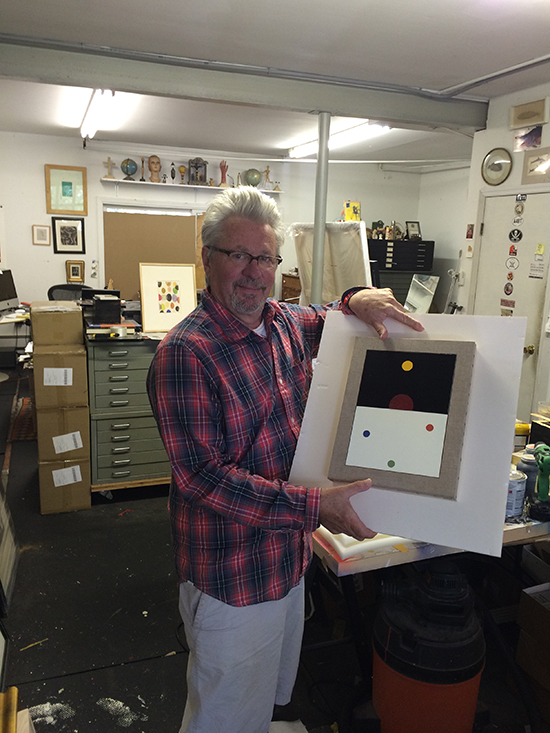
Dan Rizzie with a recently completed work: painting and collage. AB Photo.
.
Now that he’s taking a breath and considering what lies ahead, he smiled and said, “It’s impossible to say what I’m going to do, because I never really know until I’m doing it.”
It’s perhaps this kind of thinking that prompted Terrie Sultan to choose this quote from the artist as the title for her interview in Dan Rizzie: “My train of thought makes many stops.”
He knows at least this much: To begin the next phase of his career, he’s thinking of trying to get a sabbatical grant for one year so that he can revamp his studio in North Haven.
.
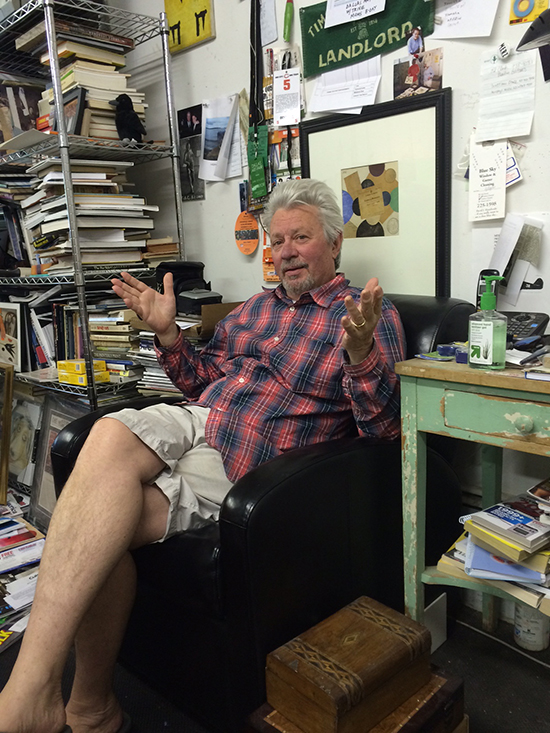
Dan Rizzie in his studio. Photo by AB photo.
.
While artists’ working spaces traditionally range from fanatically neat to mirrors of their inhabitants’ explosive imaginations, Rizzie’s studio has gathered so much clutter as to become unmanageable.
One end of the space is piled high with guitar cases, guitars and a keyboard. To get from one end of the studio to the other, the artist has to follow narrow paths that wind through stacks of books, works in progress and finished pieces, surfaces strewn with artist’s materials, and a vast array of found objects, cutouts and sculptural figures.
.
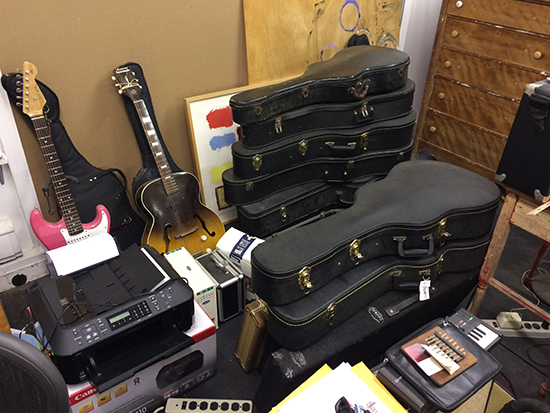
A few of the many guitars crowding one end of Dan Rizzie's studio. Photo by AB Photo.
.
Because of the way he works, “I don’t throw anything away,” he said, his voice trailing off, “and then you wind up with a space like this…”
.
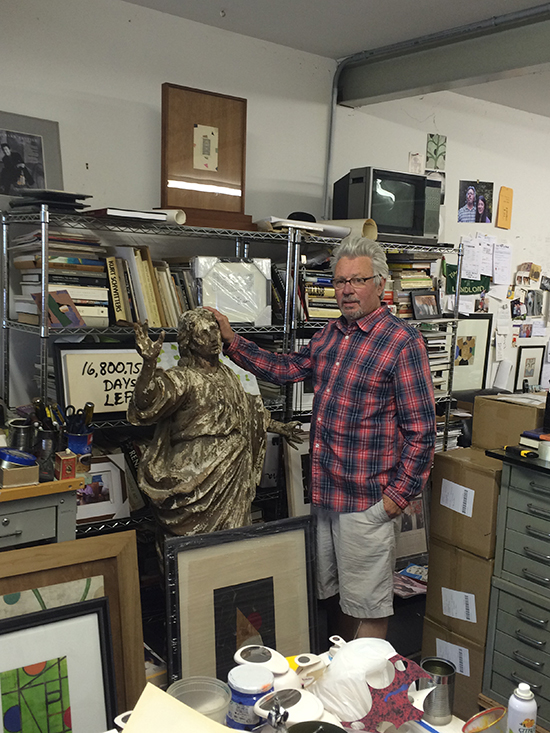
Every object, book, artwork and musical instrument in Dan Rizzie's studio has a story. Photo by AB photo.
.
Reviewing his process over the years, Rizzie noted that he started out working principally on a smaller scale, but was always interested in larger size. He has made works ranging from the size of a postage stamp to as large as he could go, covering entire walls. “I love working large,” he said, “and I love working small.”
.
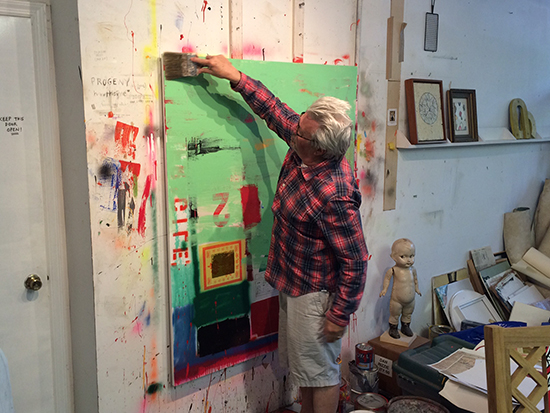
Dan Rizzie working in his studio. Photo by AB photo.
.
Regardless of scale, he has used the same approach from the beginning of his career right up to today. It’s an approach that begins with creating a surface, typically by changing an existing surface.
“I always to do something to a surface and then paint or work over it; I love that look and feel,” he said. “Venice is one of my favorite cities, and it’s that way: painted over many times with some of the earliest layers of paint, centuries old, still visible.”
For his paintings, he starts with a blank surface, whether it’s on a board or canvas or other material. He then covers it with paper, often newsprint, because, he said, “I prefer working on top of paper.”
For prints, he takes the most perfect, mirror-clear, polished piece of copper and then flips it like a playing card across a concrete floor to scratch it up and give it texture before he starts to incise the marks that will yield drawings of shapes and forms into the metal.
Regardless of the medium, he needs to change the surface before doing anything else, to create the surface. The effect, he said, is to emulate “somewhat the way nature works on things,” changing surfaces throughout the environment.
.

"Shelter Island" by Dan Rizzie.
.
He first started coming out to eastern Long Island with his father in the early 1960s. After graduate school, he spent time going back and forth between Dallas and New York for many years, and resumed spending summers on the East End, moving to North Haven permanently in 1989.
Asked about the flower and bird images that began to show up and then dominate much of his later work, Rizzie observed that “in Dallas and New York, you look out the window and it’s all hard-edge geometry. In Long Island, you see birds and the shapes of trees; it’s such a beautiful place. And these images found their way into my work.”
.
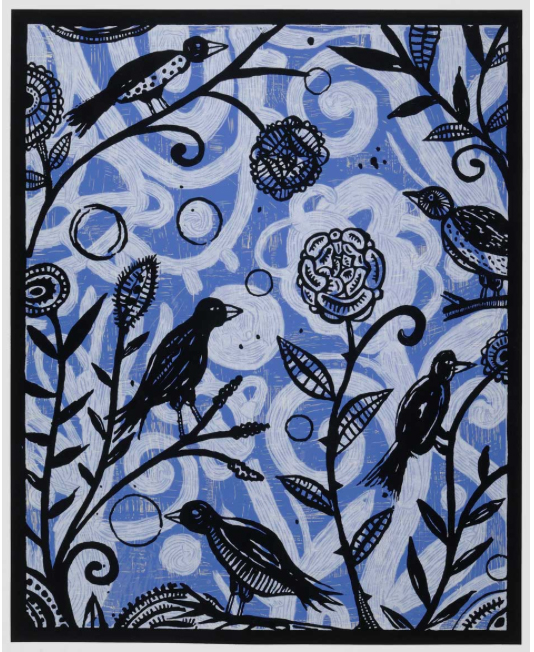
Artwork by Dan Rizzie.
.
Going forward, as he gets his studio cleared out and revamped, what will the imagery be? What will future works look like? He doesn’t really know. And that’s fine with him.
“It’s hard to say what I’m going to do, working the way I work,” he said. “I do have ideas; I keep a notebook, but I don’t like to sketch anything out.”
“The real test of what a painting is going to be comes a few moments before it’s finished,” he said. “A big problem is knowing when to stop, when it’s done. That’s a real gift.”
“I went for quite a while overworking things,” he mused. “Doing the work is how you figure out what is the right amount of work.”
___________________________
Copyright 2015 Hamptons Art Hub LLC. All rights reserved.
